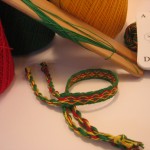Rigid-Heddle Weaving Basics (6-108)
class is FULL
Syne Mitchell
Saturday all day 6-hr class
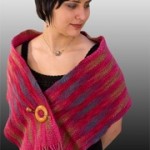 This class is a wonderful introduction to rigid-heddle weaving. Students warp and weave off a scarf in a day using gorgeous hand-painted warp and matching weft. Lessons learned along the way include: peg method of warping a rigid-heddle loom, how to weave efficiently and well (and get good selvedges), how to calculate how much yarn is needed for a project, color theory for weaving, repair techniques for weaving errors off the loom, and finishing techniques.Students should bring their own rigid-heddle looms; a few looms will be available for rent.
This class is a wonderful introduction to rigid-heddle weaving. Students warp and weave off a scarf in a day using gorgeous hand-painted warp and matching weft. Lessons learned along the way include: peg method of warping a rigid-heddle loom, how to weave efficiently and well (and get good selvedges), how to calculate how much yarn is needed for a project, color theory for weaving, repair techniques for weaving errors off the loom, and finishing techniques.Students should bring their own rigid-heddle looms; a few looms will be available for rent.
Skill Level: Beginning
Materials Fee: $20
Students should bring: Rigid-heddle looms; a few looms will be available for rent.
Tablet Weaving Basics (6-109)
John Mullarkey
Saturday all day 6-hr class
We will start with a discussion on how to read and design tablet weaving drafts. Then we will proceed to setting up the cards, weaving the band, and a discussion of finishing techniques.
Skill Level: Beginning
Materials Fee: $15
Students should bring: Scissors, yarn needle, three balls or cones of yarn, at least one ounce of each of10/2 mercerized or unmercerized cotton or #10 crochet thread.
The Nuts & Bolts & Theory of How Collapse Works (3-110)
class is FULL
Peggy Osterkamp
Saturday morning 3-hr. class
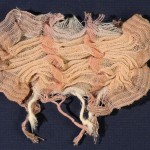 Learn how to weave and control to some degree cloth that puckers using over-twisted and regular yarns. The over-twisted yarns cause the cloth to collapse (pucker) when the cloth is put into water. Then the yarns swell and the twist forces the yarns to move and the cloth to pucker. Topics covered: how to wash and control the puckers, what yarns work and how to identify them, sett in warp and weft, weaves that can give a lot of pucker, how S & Z enters the picture, how over-twist works and the amount of twist needed, and how to calculate how much twist is in commercial yarns and to add twist to them with a spinning wheel. Spinners are welcome.
Learn how to weave and control to some degree cloth that puckers using over-twisted and regular yarns. The over-twisted yarns cause the cloth to collapse (pucker) when the cloth is put into water. Then the yarns swell and the twist forces the yarns to move and the cloth to pucker. Topics covered: how to wash and control the puckers, what yarns work and how to identify them, sett in warp and weft, weaves that can give a lot of pucker, how S & Z enters the picture, how over-twist works and the amount of twist needed, and how to calculate how much twist is in commercial yarns and to add twist to them with a spinning wheel. Spinners are welcome.
Skill Level: Intermediaate and above
Materials Fee: $10
Students should bring: “Pick glass”, aka “linen tester”, or a magnifying glass. Paper cutting scissors. Note-taking materials. Cheap calculator (able to do square root). Any yarns you want to try out to see if they collapse. Any yarns you would like to add twist to. Ruler or tape measure. Bobbin winder if you can bring one (we need a few). McMorran balance if you can (we need a few). Partial roll of toilet paper, optional.
Weave Structures–Tied Weaves (3-112)
Robyn Spady
Saturday morning 3-hr. class
Do terms like “single two tie” or “single three tie” bewilder you? Are you curious about what makes a tied weave a tied weave? For weavers interested in understanding terms like “summer and winter” and how they related to “taqueté”, or in exploring Quigley and Bergman tied weaves, then this class is for you! All of this establishes a foundation for understanding the double two tie threading and its incredible versatility.
Skill Level: Advanced Beginner (an understanding of blocks is helpful)
Materials Fee: $5
Students should bring: Paper and pen or pencil for note taking.
Inkle Woven Ribbons (6-305)
class is FULL
Sara Lamb
Sunday all day 6-hr. class
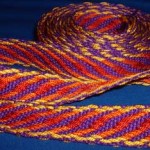 Inkle looms are easy to use and provide the basis for beautiful fabrics in plain to complex weave structures. Learn to warp and weave on an inkle loom with cotton or silk threads. Note: If you’re taking Sara’s Silk Spinning class on Saturday, you can use your handspun silk for your inkle project. Students must bring their own inkle looms.
Inkle looms are easy to use and provide the basis for beautiful fabrics in plain to complex weave structures. Learn to warp and weave on an inkle loom with cotton or silk threads. Note: If you’re taking Sara’s Silk Spinning class on Saturday, you can use your handspun silk for your inkle project. Students must bring their own inkle looms.
Skill Level: Beginning
Materials Fee: $10
Students should bring: Inkle loom.
Two Pack Tablet Weaving (6-309)
John Mullarkey
Sunday all day 6-hr. class
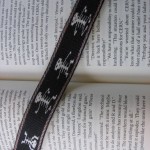 Learn two tablet weaving techniques which require turning packs of individual cards – double faced weaves and double-card double-turn diagonals. We will start by setting up using the circular warping technique. During the first half, we will discuss double-card double-turn “Egyptian” diagonals and learn the tips and tricks of managing two packs of cards to turn. The second half will be spent designing and creating motifs with the double-faced weaving technique.
Learn two tablet weaving techniques which require turning packs of individual cards – double faced weaves and double-card double-turn diagonals. We will start by setting up using the circular warping technique. During the first half, we will discuss double-card double-turn “Egyptian” diagonals and learn the tips and tricks of managing two packs of cards to turn. The second half will be spent designing and creating motifs with the double-faced weaving technique.
Skill Level: Beginning (students should have a basic understanding of tablet weaving)
Materials Fee: $15
Students should bring: Scissors, yarn needle, four balls or cones of 10/2 mercerized or unmercerized cotton or #10 crochet thread. Each ball should be at elast 1 ounce. Two balls of one color, and two balls of a different highly contrasting color. Graph paper and colored pencils.
Weaver-manipulated Lace Weaves (6-312)
Robyn Spady
Sunday all day 6-hr. class
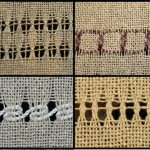 If your loom can weave plain weave, there are some amazing weaver-manipulated lace weaves that are possible, including Danish medallion, leno, Spanish lace, Brooks bouquet, ladder hemstitching, and more! These weaves are great for embellishing fabric and adding that little something extra without needing more than two shafts. This class is appropriate for both multi-shaft and rigid heddle looms.
If your loom can weave plain weave, there are some amazing weaver-manipulated lace weaves that are possible, including Danish medallion, leno, Spanish lace, Brooks bouquet, ladder hemstitching, and more! These weaves are great for embellishing fabric and adding that little something extra without needing more than two shafts. This class is appropriate for both multi-shaft and rigid heddle looms.
Skill Level: Beginner
Materials Fee: $5
Students should bring: A pre-warped loom capable of weaving a plain weave cloth (including rigid heddle looms), shuttle, weft, and scissors. (Note: This one-day workshop is designed partly with those in mind that brought looms for other workshops and wish to see more versatility with their loom set-up.)
Supplementary Warp Techniques: How to Weave with Extra Warps (3-310)
class is FULL
Peggy Osterkamp
Sunday morning 3-hr. class
Supplementary warps are extra warps that are not needed for the foundation, or main cloth. They are made separately and float on top of the cloth for patterning. When they are not showing on the surface, they are floating below the cloth. This differs from double weave in that the threads could be removed and a stable cloth would still remain. Precious yarns can be used sparingly and effectively using this technique because they are only used for patterning or to enrich a ground weave. The designs can be very flexible, with a variety of patterns possible on one warp.
In this seminar we’ll address how the warps are made, beamed, threaded, and woven, and how to design and create drafts. Other supplementary warp techniques to be mentioned but not explored in depth at this time are: velvet, turned overshot, mitered corners, and pick-up techniques. The principles of supplementary warp can be used to weave more than one warp in other applications as well, such as double or triple cloth.
Skill Level: Intermediate weaving and above
Materials Fee: $5
Students should bring: Note taking materials. Sharp pencils. Eraser.
Overshot to Doubleweave: Color & Weave with a Colonial Touch (3-313)
class is FULL
Jannie Taylor
Sunday morning 3-hr. class
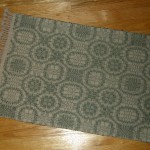 Learn how to take any 4 shaft overshot pattern and rewrite it as a patterned doubleweave on either 4 or 8 shafts. The transformed design retains the best features of overshot designs, i.e., large, interesting motifs; half-tone shading; and a traditional look without the drawback of long floats.
Learn how to take any 4 shaft overshot pattern and rewrite it as a patterned doubleweave on either 4 or 8 shafts. The transformed design retains the best features of overshot designs, i.e., large, interesting motifs; half-tone shading; and a traditional look without the drawback of long floats.
Skill Level: All levels
Materials Fee:$2
Students should bring: Notebook and pen.
Tips and Tricks with the AVL Warping Wheel (3-405)
class is FULL
Jannie Taylor
Sunday afternoon 3-hr. class
Warping Wheel owners, and any weavers who want to get sectionally warped, need to attend this informative, hands-on seminar. Starting with basic techniques for sectional warping, go on to learn techniques not found on the instructional video: how to beam two sections at a time; how to wind on once and beam 3 sections; how to make an easy “ikat” warp; how to take bouts off for dyeing and then put them back on; and much more.
